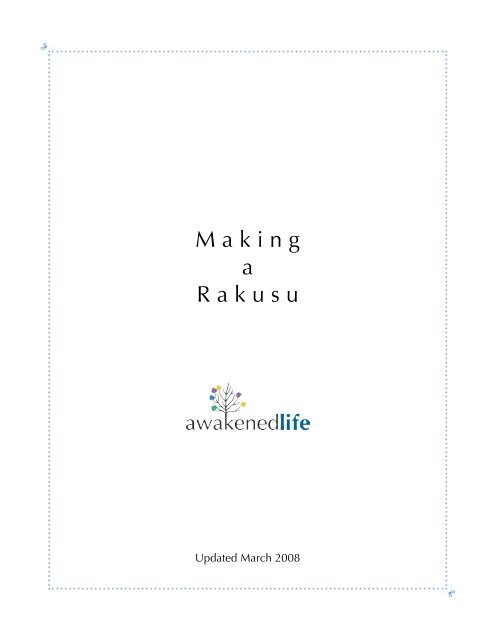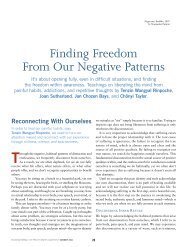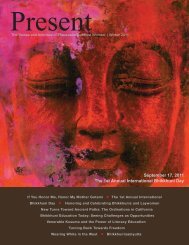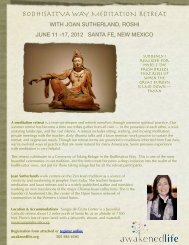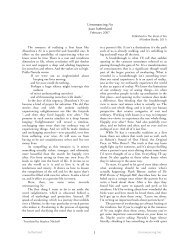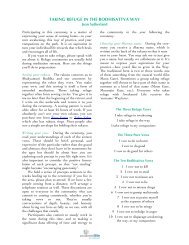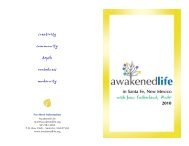Rakusu Instructions - Awakened Life
Rakusu Instructions - Awakened Life
Rakusu Instructions - Awakened Life
You also want an ePaper? Increase the reach of your titles
YUMPU automatically turns print PDFs into web optimized ePapers that Google loves.
M a k i n g<br />
a<br />
R a k u s u<br />
Updated March 2008
NOTES ON THE RAKUSU<br />
The rakusu represents the robes that Shakyamuni wore, and we wear it in memory of the Buddha’s<br />
teachings. We also remember those whose commitment and courage carried Chan/Zen through the centuries<br />
so that we can live it now : The rakusu was created during the devastating persecutions of Buddhism in<br />
China during the 9 th century CE. Monastics were forcibly returned to lay life, and some of them made<br />
rakusus, which could be easily hidden under ordinary clothes, as a miniature version of the robes they were<br />
no longer allowed to wear.<br />
Sewing a rakusu takes some time, and that's what lets our hearts and psyches in. We have to stop; we<br />
have to not do all the other things we spend our time doing, and we sit and sew. In sitting and sewing, alone<br />
and in the company of our rakusu-making friends, we begin to hear the small voices often drowned out—<br />
voices from our heart-mind and from the world around us—and that wisdom and those blessings are<br />
stitched into our rakusus as well.<br />
We make the rakusu out of lots of little pieces of fabric stitched together by hand. It's like our lives : We<br />
make a life from bits of this and that, and after awhile a pattern begins to emerge. In ancient times<br />
monastics would go to the town dump to pick up pieces of different fabric, dye them one color, and sew their<br />
robes from them. Out of many, one—and nothing rejected, nothing excluded.<br />
<strong>Rakusu</strong>s are usually made of dark colors because they’re<br />
of the dark earth from which we all come, of which we’re made,<br />
and to which one day we’ll return. There's a quilt-like pattern in<br />
the center of the rakusu which represents the rice fields that<br />
are the foundation of Asian Buddhist cultures. It connects us<br />
to all the careful cultivation of land and the Way that's gone<br />
on through the generations.<br />
The rakusu is continuous all the way around except for one<br />
place, the ring. Traditionally this was made of bone, but now<br />
it’s usually made of wood or plastic, though ceramic or other<br />
1<br />
VERSE OF THE RAKUSU<br />
This is the robe of freedom<br />
the bare field, the blessings.<br />
I receive the Tathagata’s teaching<br />
which wakes all beings.<br />
materials would work as well. This is the one place there's a gap, and resting in the gap is a circle that<br />
represents the infinite. So it's through the place that's not continuous, through the crack, that the light of<br />
the vastness emerges.<br />
You sew a green pine needle on the piece that sits at the nape of your neck. This represents the<br />
mountain and forest traditions out of which we come. It also represents all living things, long life, and, like<br />
pine needles that come in bundles, the many out of one.<br />
The first time you put on your rakusu each day, place it, still folded, on top of your head, put your palms<br />
together, and recite the Verse of the <strong>Rakusu</strong>. Thereafter, you can just touch the rakusu to your forehead<br />
and put it on. <strong>Rakusu</strong>s can be worn anywhere except into a bathroom; if you’re working you can turn the<br />
rakusu around so that the pine twig is at your throat and the rakusu hangs down your back. It’s customary<br />
to put it on your cushion rather than the floor and not to stack anything on top of it. You should be able to<br />
spot clean or dry clean your rakusu, but the writing on the underside might not survive laundering.<br />
When you’ve finished sewing your rakusu you’ll give it to your teacher, who puts it on her or his altar and<br />
lives with it for awhile before writing on the white silk that will sit next to your heart. Your dharma name is<br />
there, in the formula ‘Today So-and-so takes up the bodhisattva way’, to remind you that this is not<br />
something you do once, but every day of your life. In accepting your rakusu back from your teacher, you’re<br />
committing to this Way and this community. Welcome home.<br />
Vernal Equinox 2008
2<br />
Underside for<br />
teacher to write on
MAKING A RAKUSU<br />
Your rakusu is an intricate and individual piece of work and should be made without rushing. Please<br />
allow plenty of time (30-40 hours) to enjoy making it, particularly if you’re not accustomed to<br />
sewing. It’s helpful to have a finished rakusu in front of you while you work. Read all instructions<br />
carefully before you begin. There's a glossary of sewing terms at the end.<br />
You will need :<br />
1¼ yds of dark cloth *<br />
½ yd of white cloth **<br />
½ yd of black non-fusible interfacing<br />
1 ring of a material like wood, 2¼" –<br />
2¾" in diameter ***<br />
1 length of green embroidery thread<br />
3<br />
Large cutting mat (24" x 36")<br />
Rotary cutter<br />
Large transparent measuring square<br />
White chalk or pencil and chalk wheel<br />
for marking on fabric<br />
* The dark cloth can be black, brown, grey, or navy blue—a color representing the dark earth.<br />
Medium-weight cotton is the easiest to work with, but any fabric is fine. Pre-wash before you begin<br />
sewing in case the fabric shrinks. If you already have fabric that’s meaningful to you in some way<br />
you can dye it a dark color and use that.<br />
** Tightly woven, shiny silk with some weight to it is the best fabric to write on. Whatever fabric<br />
you choose, the tighter the weave and the smoother the surface the better.<br />
*** Make your own, or buy one on the Zabu Zabu website.<br />
1. Using white chalk or a sharp white pencil, accurately mark all pattern pieces along the straight<br />
grain of the fabric (parallel to the selvages); don't include the selvage in any of the pieces.<br />
Double check before cutting anything. There are patterns for pieces A-D in Appendix C; for the<br />
rest, use the measurements below. You'll end up with 16 pieces of dark cloth, 2 pieces of white<br />
cloth, and 2 pieces of interfacing. Always use the straight grain of the fabric.<br />
ON DARK CLOTH :<br />
1 each of A 1 & A 2 , 11" x 3"<br />
4 of B, 9" x 1½"<br />
2 of C, 10" x 1"<br />
1 of D, 10" x 3"<br />
1 of E, 36" x 4½"<br />
1 of F, 14½" x 4½"<br />
1 of G, 9" x 2¼"<br />
1 each of H & J, 42" (for small person)<br />
to 46" (for large person) x 4½"*<br />
1 each of K & L, 10" x 4½"<br />
ON WHITE CLOTH :<br />
1 of O, 10" x 4"<br />
1 of P, 12½" x 9"<br />
ON INTERFACING :<br />
1 of M, 15½" x 11½"<br />
1 of N, 10" x 4½"<br />
* These are the straps, which go from one side of<br />
the rakusu, across the back of your neck, to the<br />
other side. Measure to find approximately the<br />
right length for you; you’ll have a chance to<br />
shorten them later if necessary.
2. Carefully cut all these pieces, using the rotary cutter to make clean lines. When you start<br />
sewing, you'll be using the seam allowance as your guide, so be precise.<br />
3. The first part you'll work on is the center quilt-like section. With the pattern pieces in Appendix<br />
C as a guide, use chalk to mark the seam allowance lines and the tuck lines on the wrong sides<br />
of strips A, B, C, and D. If your strip of cloth is longer than the pattern, don't trim it, but be<br />
sure the tucks marked ‘centered’ on the pattern pieces are in the middle of the strip. To make a<br />
tuck, bring right sides together, folding in the middle of the 2 tuck lines and matching the tuck<br />
lines. Stitch on the tuck lines by machine using a basting stitch, or by hand. Press the tucks in<br />
the direction shown by the arrows on the pattern.<br />
4. Join these center section pieces together by hand or machine, as in the diagram below and on<br />
page 1. Start with strip D (the middle strip) and add strips B, C, and A in the order indicated in<br />
the diagram. Make sure that pieces are always right sides together before sewing, and that<br />
the tucks are in the right places. As an example, place D and one of the B’s right sides<br />
together, aligning one long edge. Stitch along that edge, following the seam line exactly. Press<br />
all seam allowances toward the B pieces.<br />
5. Lay the sewn center section in front of you. Measure and mark with a chalk wheel 1/16 " wider<br />
than a rectangle 6" high x 9 3/4" wide, so that the border pieces will cover these chalk lines.<br />
Don't trim off the excess.<br />
RAW<br />
EDGES<br />
CHALK<br />
LINE<br />
6. On interfacing piece M, pin and press a 1" fold on all 4 sides, so that the cloth measures exactly<br />
9½" x 13¼" when folded. You might have to adjust the folds so that the cloth measures these<br />
dimensions precisely.
7. Place the sewn center section, right side up, in the middle of interfacing piece M, so that<br />
there's a space just slightly less than 1¾" between the chalk line on the center section and the<br />
folded edge of the interfacing. Pin, then baste with small stitches. Press.<br />
PINS<br />
5<br />
EDGE<br />
8. Turn the whole thing over and place white cloth piece P in the middle, right side up, so there's<br />
about ¼" between the raw edges of P and the edge of the interfacing. Pin. Baste with small<br />
stitches ¼" from the edge of P. Press.<br />
9. Press border piece E exactly in half lengthwise, then<br />
press both raw edges inside so that it measures 1¾"<br />
all the way along.<br />
STITCHING<br />
LINE<br />
RIGHT<br />
SIDE<br />
10. Border piece E wraps around the sides and bottom of<br />
the center section; the top of the center section is<br />
left unfinished for now. Starting at the top left corner of the center section, tuck border E<br />
around the folded edge of the center section interfacing, ending at the top right corner. Pin as<br />
you go, making sure that the edge of the interfacing fits snugly into the crease of the border.<br />
Don't worry about the corners yet; just keep the interfacing edge and the border crease<br />
together. The folded edge of border E will just cover the chalk line. Does it look like this diagram?<br />
Make sure the center section is the right way up.
11. Now the corners. On the front, fold the excess cloth<br />
inside, under the side edges (represented by the dashed<br />
lines). You’ll have to unpin a little to get the fold to lie<br />
neatly, then re-pin. On the back, fold the excess cloth the<br />
opposite way, under the bottom edge, to distribute the<br />
bulk evenly.<br />
12. Baste the inner and outer edges of the border, taking<br />
care not to dislocate the edge of the center section from<br />
the crease of the border.<br />
13. By hand, slip-stitch the border's inner edge and corners on the front. Your stitches should pick<br />
up the interfacing but not come through to the back. Then turn the whole thing over and stitch<br />
the back in the same way. Press carefully. Trim off the raw edges of border E so that they are<br />
in line with the top edge of the rakusu.<br />
14. Press border piece F in the same way as you did border E (see 9). Fold it over the top edge of<br />
the center section, again making sure it's a snug fit. Pin. Baste. Tuck the ends of F neatly<br />
inside themselves, with the excess cloth folded towards the back of the rakusu. Slip-stitch the<br />
front first, then the back.<br />
15. On piece G, press a crease ½" from one edge, along the<br />
length of the cloth. On the other edge, press a crease ¼"<br />
from the edge.<br />
16. Fold G in half lengthwise to find the center and mark it with<br />
a pin. Fold the rakusu in half lengthwise to find the center.<br />
Line up the centers. Fold G over the top edge of the rakusu,<br />
so that ¼" shows in front and 1" shows in back.<br />
17. Pin G to F, folding in the ends neatly, at a right angle in the<br />
front and forming a slant in the back (See diagram on page<br />
1). If there's too much bulk when you fold the ends in, trim<br />
some of the excess folded-in cloth on both the front and<br />
back. Be careful not to cut any seams. Press. Baste. Slipstitch<br />
through all layers to give the edge a firm finish, taking<br />
care to make even stitches.<br />
18. Now the straps. Fold pieces J, H, and L lengthwise, right sides together. Pin the raw edges<br />
together and press. Machine or hand stitch ½" from the raw edges, leaving one end open on all<br />
three pieces. Double stitch the corners so they don’t pull out when turning. Trim the seam<br />
allowance to ¼" and clip the corners. (See diagram below) Carefully turn the pieces right side<br />
out through the openings at one end, with the aid of a ruler or a chopstick. Use a pin to make<br />
sharp corners. Press.<br />
6<br />
RIGHT SIDE
19. Pin K and N wrong sides together and baste the long sides ¼" from the raw edges. Fold in ½"<br />
on each long side and press. (It's easier to get these pieces to sit flat if you baste one side,<br />
then press and baste the other side.)<br />
¼” baste<br />
3 ½”<br />
½” folds<br />
20. Fold under ¼" on the long sides of piece O and press. Pin O to K/N so that 1/8 " of K shows on<br />
either side of O. Baste, then slip-stitch. Fold the raw ends ½" in, toward the center of O, and<br />
press. Mark the center of each side with a pin.<br />
21. Pin the finished ends of straps J and H to the top edge of the rakusu, on the left as you look at<br />
it (See diagram on page 1). The seamed edges of the straps should be towards the center of<br />
the rakusu. Stitch them securely to the top edge of the rakusu from the back, without coming<br />
through to the front. Pin L and the other end of H in place on the right, in the same manner.<br />
22. Draw the edges of J and L through the rakusu ring and pin temporarily to get an impression of<br />
how it will look. Try the rakusu on and check in the mirror. The bottom edge of the rakusu should<br />
come to approximately 2" below your navel when you're standing up. If it's too long, shorten the<br />
straps on the right side where the ring is. Place your hands together at your solar plexus to<br />
help you judge. When you're satisfied, pin the straps firmly in place.<br />
7<br />
WRONG SIDE<br />
RIGHT SIDE
23. Fold the rakusu in half to find the center<br />
back of the straps, where they'll rest at the<br />
nape of your neck. Mark the center back on<br />
both straps with chalk. Using the ½" fold you<br />
made in 20, wrap the raw edges of K over the<br />
straps, lining up the center points, and pin.<br />
Cross-stitch the raw ends of K to the<br />
straps and bring the two ends of K together,<br />
so the straps are sandwiched inside K. Slipstitch<br />
the folded edges of K together. Press.<br />
24. Fold a portion of the long edges of L, one over the other, to the front, as in the diagram; stitch<br />
invisibly but firmly through all layers. Press well. Stitch the unfolded portion of L to the rakusu<br />
in the same manner as the other straps. Draw the folded portion of L through the ring. The<br />
strap should measure 1½" from the edge of the ring to the top of the unfolded portion. Cut off<br />
any extra and finish the raw end of the strap neatly. (You can tuck in the ends and slip-stitch<br />
them closed or whip-stitch the ends together.) Stitch the folded end of the strap to the top<br />
edge of the rakusu at the back.<br />
25. Finish the raw end of H (as in 24) and sew it to the rakusu in the same manner as the other<br />
straps. Finish the raw end of J and tie it to the ring. It may take some practice to get the knot<br />
to sit at the right length. It will hold itself in place if you pull the strap taut after tying it. It’s<br />
usually not stitched.<br />
26. The last thing is the broken pine twig on piece K at the center back of the straps. Thread your<br />
needle with green embroidery thread and practice on a spare piece of cloth. If you like, mark the<br />
main points with chalk on piece K to guide you. Stitch through all layers; the design should look<br />
as pleasing on the underside as on the outside. The numbers on the diagram indicate the order<br />
in which to take the stitches. The dashed lines represent stitches on the underside, invisible on<br />
the outside; these underside stitches are as long as the ones on the outside. Each stitch is<br />
8<br />
RIGHT<br />
SIDE
quite long; stitch #1, for example, begins at the point marked “Start Here” and extends all the<br />
way past stitch #5.<br />
You've finished your rakusu. Congratulations!<br />
9
APPENDIX A : GLOSSARY<br />
BASTING : Basting is a long temporary stitch that’s<br />
removed after sewing the permanent seam. However, in some<br />
steps the basting stitch is the permanent seam. Slide the<br />
needle through the fabric, spacing stitches evenly.<br />
CROSS-STITCH: Bring the needle out at 1, cross over and<br />
insert the needle at 2, coming out at 3. Cross over and insert<br />
the needle at 4, coming out at 5. Continue, making a row of<br />
diagonal stitches. At the end of the row, reverse direction to go<br />
back over the row, creating a line of X's.<br />
INTERFACING : A special lining available at fabric stores that adds some stiffness or weight to<br />
fabric. Non-fusible means NOT the kind that can be fused to the fabric by ironing.<br />
PINNING : When you pin two pieces of cloth together before sewing a seam to join them<br />
permanently, pin at a 90° angle to the seam line so that the needle will go right over the pins.<br />
RIGHT SIDE / WRONG SIDE : The right side of the fabric is the one that will be on the outside<br />
of the finished rakusu; the wrong side is the side that will be hidden on the inside.<br />
SEAM ALLOWANCE : The distance between the edge of a piece of fabric and the stitching that<br />
forms a seam parallel to the edge.<br />
SELVAGE : The finished edges of a piece of fabric, usually the outside edges as the fabric comes<br />
off the bolt.<br />
SLIP-STITCH : Slip-stitching is used to join a folded edge<br />
to a flat surface. Take a tiny stitch on the flat surface just<br />
under the folded edge, insert the needle into the fold, slide<br />
it some distance in the fold, and bring the needle out of the<br />
fold. Repeat.<br />
STAB-STITCH : Stab the needle through the fabric, from<br />
one side to the other, making sure the stitches are of even<br />
length on both sides of the fabric.<br />
WHIP-STITCH (or Overhand Stitch) : Insert the needle from the<br />
back edge through to the front edge, picking up only one or two<br />
threads each time and crossing over the join between the 2 pieces<br />
of fabric.<br />
10
APPENDIX B : PATTERN FOR A RAKUSU HOLDER<br />
The rakusu holder is in the shape of a large envelope; it's usually made of a beautiful piece of<br />
fabric, with a lining of a smooth material like silk that allows the rakusu to slide in and out<br />
easily.<br />
1. Cut two pieces 12½" x 24", one of the outside fabric and one of the lining. On each piece, mark<br />
the center of one short end and 8" from the corners of that end on both long sides. Draw<br />
straight lines from the center mark to the two marks on the sides and cut along the lines.<br />
12½<br />
"<br />
2. Pin the two pieces to each other, right sides together.<br />
3. Sew by machine or small hand stitch ¼" to ½" from the raw edge all the way around, leaving a<br />
1½" opening on one long side. (Make sure the rakusu will fit within the seam lines.)<br />
4. Pull the whole thing right-side out through the 1½" opening. Iron flat along the seam edges.<br />
Hand stitch the 1½" opening closed.<br />
5. Lay the piece flat with the lining facing downwards. Fold the bottom third (the side without the<br />
point) up over the middle third and stitch together along the sides.<br />
OUTSIDE<br />
FABRIC<br />
LINING<br />
6. Turn the pocket created by the side seams inside out, so that the outside fabric is now on the<br />
outside. Press the flap down over the pocket.<br />
7. Fold your rakusu in half vertically so that the underside is on the outside, left side up; fold the<br />
straps straight down to the bottom of the rakusu and then back up, so the piece with the pine twig<br />
rests near the top edge of the rakusu. Slide it into the holder.<br />
11<br />
24"<br />
8"
APPENDIX<br />
C :<br />
PATTERN<br />
PIECES<br />
Cut on solid lines<br />
Sew on dashed<br />
lines<br />
Tucks<br />
Arrows indicate<br />
direction in which<br />
to press tucks<br />
NB : Both A's are<br />
a full 11" long<br />
½"<br />
A 1<br />
CUT 1<br />
½"<br />
¼"<br />
1"<br />
centered<br />
1 ¾"<br />
12<br />
¼" ¼"<br />
A 2<br />
CUT 1<br />
½"
B<br />
CUT 4<br />
C<br />
CUT 2<br />
1"<br />
13<br />
D<br />
CUT 1<br />
1½"<br />
centered


